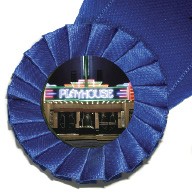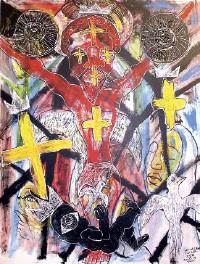Watch more than one episode of a reality show such as “Super Nanny” or “Project Runway” or “Dog Whisperer” or any of the home-design shows (or “Flava of Love,” for that matter), and you’ll notice a theme: Consistency matters. The winners of this section are a reminder of that point. Of the 13 categories, 11 of the first-place winners were in the same spot last year. One exception was in the “Best Local Athlete” category, for which there was no clear winner. But it’s the other category — “Best Sports Team” — which is particularly telling and proves the consistency maxim. Last year, the Grizzlies ruled. This year, after a very disappointing season, they’re in third place behind the (undeniably hot) University of Memphis men’s basketball team at number one and the Memphis Redbirds (who had an awful season themselves) at number two.
Best Golf Course
1. The Links at Galloway
2. TPC at Southwind
3. The Links at Overton Park — tie —
Spring Creek Golf Course
Tucked into one of our city’s nicest neighborhoods, Galloway has been one of our city’s finest courses for almost half a century. A recent multimillion-dollar renovation made something good even better, with much nicer fairways, greens as flat as a pool table, a lovely clubhouse that replaced the stone-covered building — all in a parklike setting.
Best Museum
1. Memphis Brooks Museum of Art
2. Memphis Pink Palace Museum
3. Children’s Museum of Memphis — tie —
Dixon Gallery & Gardens — tie —
Stax Museum of American Soul Music
The oldest art museum in Tennessee continues to draw crowds to its galleries. Originally a tiny jewel box in Overton Park, a massive expansion project helped turn the Brooks into one this country’s top museums.
Best Art Gallery
1. David Lusk Gallery
2. Jay Etkin Gallery
3. D’Edge Art & Unique Treasures
We’ve spent many fine evenings attending openings at David Lusk, which features an outstanding roster of artists. They also host an absolutely-have-to-be-there event for Memphis art lovers — “The Price Is Right,” an annual sale of works for under $1,000.
 Justin Fox Burks
Justin Fox Burks
Best Live Theater
1. Playhouse on the Square
2. The Orpheum
3. Theatre Memphis
Jackie Nichols’ Playhouse on the Square has consistently presented top-notch performances for more than a quarter century. Operating out of the old Memphian movie theater on Cooper, Playhouse is in the midst of erecting a state-of-the-art facility across the street, which will provide them even greater opportunities.
Best Movie
Theater
1. Malco Studio on the Square
2. Malco Paradiso
3. Muvico Peabody Place
We can remember when the only thing that stood behind Paulette’s was a parking lot. Then Malco had the idea to construct a “boutique” theater, one with intimate auditoriums and featuring films that somehow missed the larger circuits. Well, that gamble paid off, big time, and Studio on the Square is without question one of the best places in town to watch a movie.
Best Casino
1. Horseshoe Casino
2. Grand Casino
3. Sam’s Town
Our readers must feel lucky at the Horseshoe, a perennial Best of Memphis winner. Horseshoe also features some of the coolest musical and comedy acts on tour.
Best Picnic Spot
1. Shelby Farms
2. Overton Park
3. Chickasaw Gardens Lake/Pink Palace Museum
On weekends, it’s getting harder and harder to find a nice quiet spot to set down a blanket and have a picnic, but we agree that Shelby Farms probably offers the most choices, and it is an amazing thing to “get away from it all” even though you are still smack-dab in the middle of everything.
Best Place To Meet Singles
1. Church
2. Online
3. Beale Street
This category certainly told us a lot about our readers. We’d hoped that those of you who went to church did so for spiritual enlightenment and not to check out the hot chick or guy in the choir.
 Justin Fox Burks
Justin Fox Burks
1st Place: Best Live Theatre
Best Free Date
1. Mississippi River
2. Shelby Farms
3. Memphis Zoo on Tuesdays
We hope that everyone who listed “Mississippi River” meant watching the river from the safety of Tom Lee Park or some other vantage point, or maybe even boating in it (though not too many people we know seem to do that, for some reason). At any rate, we hope you didn’t mean swimming in it.
 Justin Fox Burks
Justin Fox Burks
1st Place: Best Free Date
Best Family
Entertainment
1. Memphis Zoo
2. Redbirds Game
3. Children’s Museum of Memphis
The Memphis Zoo seems to be a hit with our readers for any number of reasons. Perhaps because it really is one of the best zoos in the country.
Best Sports Team
1. University of Memphis Tiger
Basketball
2. Memphis Redbirds
3. Memphis Grizzlies
We’re anxiously waiting to see if the Tigers get a #2 — even #1 — preseason ranking, but no matter how they play, Coach Cal’s Tigers have captured the hearts of Memphians.
 Justin Fox Burks
Justin Fox Burks
1st Place: Best Family Entertainment
Best Grizzlies
Player
1. Pau Gasol
2. Mike Miller
3. Rudy Gay
When the Grizzlies first came to town, all anyone talked about was a fellow named Shane Battier. But a lanky Spaniard also began to pile up points in the paint, and when Battier jumped ship, Gasol quickly became the fan favorite. We keep hearing all this talk of trades, but new coach Marc Iavaroni insists Gasol is here to stay. We hope so.
 Justin Fox Burks
Justin Fox Burks
1st Place: Best Grizzlies Player
Best Local Athlete
READERS’ CHOICE
Pau Gasol
DeAngelo Williams
Mike Miller
Loren Roberts
John Daly
Chris Douglas-Roberts
One of our colleagues, who knows quite a bit about sports in Memphis, recently declared that if Memphis ever put up a statue to its greatest athlete, it would have to decide between Larry Finch or Pau Gasol. Coach Finch didn’t garner many votes this time, and nobody drew enough votes for us to declare first-, second-, or third-place finishes, but our readers love their sports, naming players from basketball, football, and golf.

 Justin Fox Burks
Justin Fox Burks  Justin Fox Burks
Justin Fox Burks  Justin Fox Burks
Justin Fox Burks  Justin Fox Burks
Justin Fox Burks  Justin Fox Burks
Justin Fox Burks 